Explore The Beauty Of Jakar In Bumthang On Your Next Trip To Bhutan

Jakar is a gem of a town in Bhutan’s Bumthang District at 2,800 metres above sea level. It is famous for being historically rich and significantly religious with mesmerising natural beauty. Jakar serves as an entrance to some religious places in Bhutan which are great for experiencing the heritage of the country. The peaceful scenery, ancient temples and kind hospitality of the locals often catch tourists’ attention. The valleys are covered with lush green grass, typical Bhutanese houses and vibrant monasteries that provide spiritual retreats and adventurous hikes. You can visit historical dzongs, experience lively festivals and see the serene beauty of landscapes to experience an unforgettable moment.
Jakar Bhutan History
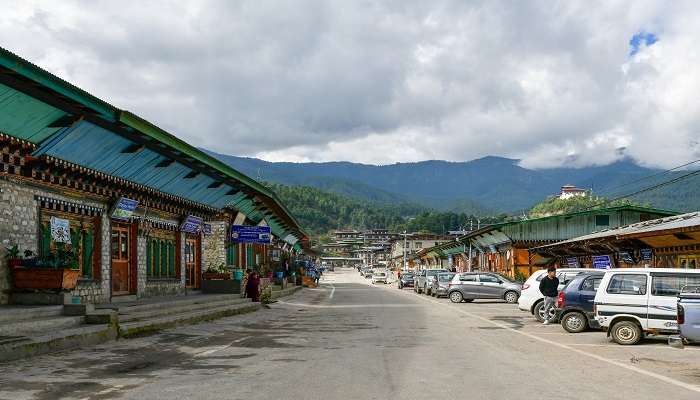
Jakar has a rich history and holds a special position in Bhutan’s spiritual and political context. It was closely associated with Guru Rinpoche, who meditated there during the 8th century and brought Buddhism to Bhutan. It is evident from the fact that many centuries-old Buddhist shrines are present. One such historical relic is Jakar Dzong, also called “Castle of White Bird”. It was built by Tibetan Lama Nagi Wangchuk in 1549 and has been used as a religious or administrative centre since then. The first king of Bhutan was born in Jakar and played a crucial role in unifying Bhutan during the early 20th century. His influence can be seen in the royal and administrative buildings of Jakar, which combine traditional architecture and historical significance that characterise Bhutan.
Must Read: Bumthang In Bhutan
Jakar Dzong
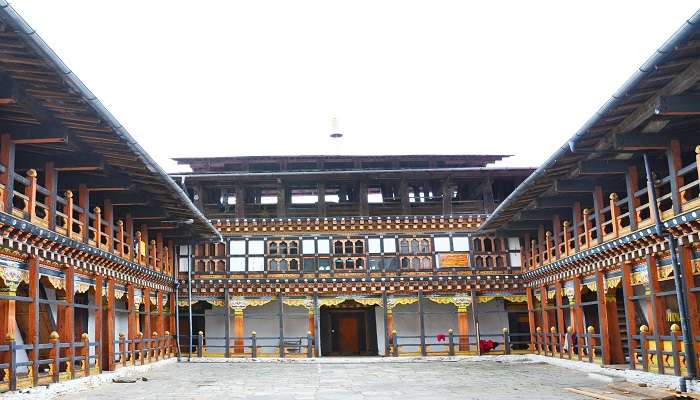
Jakar Dzong is situated on a ridge above Jakar town near Chamkhar valley in central Bhutan. It is the largest dzong in Bhutan, with more than 1500m circumference. The name Jakar comes from “bjakhab” meaning white bird signifying the founding myth about this place where a roosting white bird indicated the correct and auspicious site for establishing a monastery. It was built as an important defence fort in eastern Dzongkhags. The official name of this place is Yuelay Namgyal Dzong, which was named after winning over Tibetan ruler Phuntsho Namgyal. During the 17th century, the Tsang ruler in Tibet, Phuntsho Namgyal, sent his army twice to destroy Zhabdrung. The Dzong was damaged on both occasions but was renovated later by Trongsa Penlop. Visiting Jakar Dzong is among the top things to do in Jakar for photography and cultural exploration.
Things To Do In Jakar Bhutan
The town of Jakar offers many different activities and attractions for visitors. Whether interested in history, nature or adventure, you will find something to look forward to in this lovely town. Here is what you should not miss when visiting Jakar:
Jambay Lhakhang: Bhutan’s Spiritual Heart
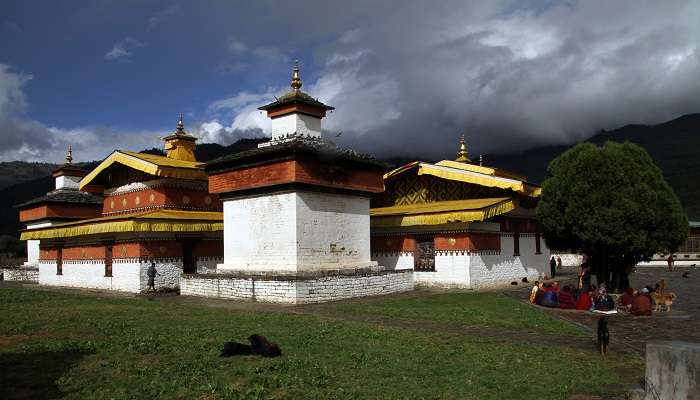
Jambay Lhakhang, also called Maitreya temple, is one of the oldest and most sacred temples in Bhutan. In 659 CE, it was constructed by King Songtsen Gampo of Tibet. This ancient temple has a deep spiritual connotation, as Guru Rinpoche visited it. There are stunning architectural structures incorporating intricate woodwork and ancient murals illustrating Bhutanese mythologies and Buddhist teachings. The Jambay Lhakhang Drup festival is one of the most exciting things where traditional mask dances, fire rituals and religious ceremonies are performed. This temple provides a unique opportunity for visitors to see Bhutanese culture, spirituality and architecture.
Visiting Hours: 09:00 AM – 04:00 PM
Entry Fees: No Charge
Suggested Read: Bhutan Hill Stations
Wangduechhoeling Palace
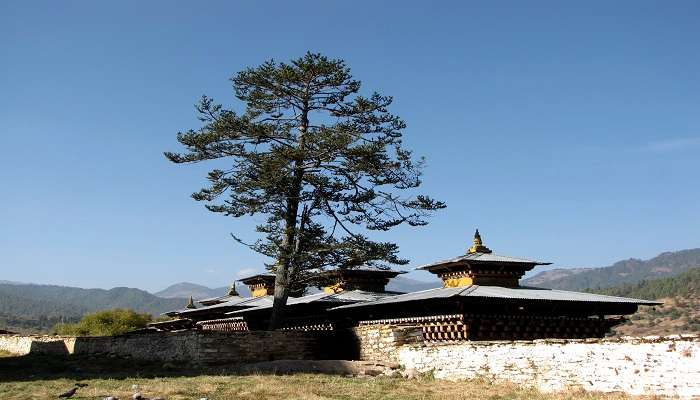
The palace offers an opportunity to delve into Bhutan’s royal past. It was built at the end of the 19th century as a home for the first King of Bhutan, Ugyen Wangchuck. It is spread over twenty acres and includes renovated buildings showcasing traditional Bhutanese architecture and artistry. There are dedicated rooms with exhibits displaying interesting artefacts, books, paintings, and relics that are indicative of the cultural history and development of this Kingdom. The palace is also connected with other places like Jampa Lhakhang and Kurje Lhakhang via picturesque hiking paths or riverside walkways, creating a peaceful sightseeing environment.
Visiting Hours: 10:00 AM – 05:30 PM
Entry Fees: INR 230 (for Indians), INR 460 (for Foreigners)
Ngang Lhakhang
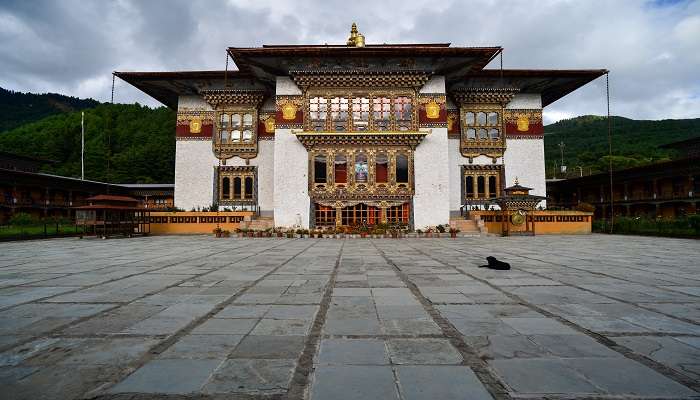
Ngang Lhakhang, also known as Swan Temple, is a historical place with greater spiritual significance built in the 15th century by Lama Namkha Samdrup. He found that an auspicious ground was spotted by a swan (Ngang-ma) moving around in circles there. The large farm-like structure of this temple has two floors and an open courtyard. Some beautiful statues of Guru Rinpoche, his consorts, and protective deities exist. The upper temple, or gonkhang, serves as a home for protective deities. Ngang Lhakhang is ideal for anyone looking to understand Bhutanese culture and spirituality, as it provides a tranquil environment for learning more about Bhutan’s spirituality.
Visiting Hours: Throughout the Day
Entry Fees: No Charge
Suggested Read: Tourist Places In Bhutan
Chakhar Lhakhang

Chakhar Lhakhang, also known as Iron Palace, is an ancient temple with a vibrant history dating back to the fourteenth century. There is a statue of Guru Rinpoche, the main deity of the temple, and statues of his consort, Tashi, among other religious artefacts. The walls have paintings and murals that date back to the 15th century, showing scenes from Bhutanese mythology. Hats and masks used during the Jambay Lhakhang Drup festival can also be seen there. The museum Dorji Lingpa’s descendants maintained displays of traditional costumes, ornaments, ritual items, and cane-made artefacts.
Visiting Hours: Throughout the Day
Entry Fees: No Charge
Tharpaling Goemba
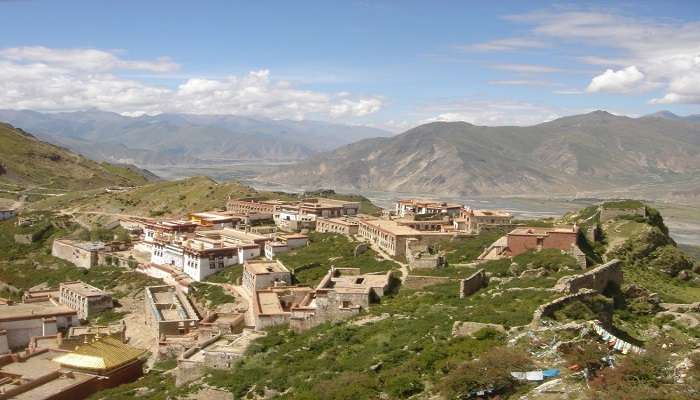
It is about 3600 metres above sea level and offers panoramic views of Chumey Valley in Bumthang. Tharpaling Monastery was founded in the 14th century by Buddhist Saint Gyalwa Longchen Rabjampa. During Longchen Rabjampa’s teachings, many devotees experienced liberation, named “Liberation”. Two temples in the monastery complex have statues of Longchen Rabjam, Guru Rinpoche and other revered figures. Later on, it was renovated by Bhutan’s first king, Ugyen Wangchuck, who also used the monastery as his retreat centre. People still visit Tharpaling Goemba to seek spiritual guidance and connect with Bhutan’s great religious traditions to find solace.
Visiting Hours: Throughout the Day
Entry Fees: No Charge
Further Read: Backpacking In Bhutan
Jakar seamlessly combines elements of natural beauty, history, and culture. Its peaceful atmosphere, combined with friendly people, makes it a great destination for those who want to explore Bhutan. As you visit Jakar, you will not only create memories of beautiful scenery but also a deep understanding of what makes this Bhutanese town truly unique. So, pack your bags and book your trip to Bhutan today to experience the serene beauty of Jakar.
For our editorial codes of conduct and copyright disclaimer, please click here.
Cover Image Credit: Jean-Marie Hullot for Wikimedia Commons
Frequently Asked Questions about Jakar Bhutan
When is the best time to visit Jakar?
The ideal time to visit Jakar is during the spring (March-May) and autumn (September-November). The weather is pleasant, and the skies are clear, making it perfect for sightseeing and trekking.
How can I reach Jakar?
You can reach Jakar by road or air. Bumthang has a domestic airport with flights from Paro and other parts of Bhutan. Alternatively, you can travel by road from Thimphu which takes around 8-10 hours.
Do I need a visa to travel to Jakar Bhutan?
Yes, all international visitors except people from India will require a visa to enter Bhutan.
Are there good accommodation options available in Jakar?
Jakar offers various types of accommodation ranging from luxury resorts, and cosy guest houses as well as traditional homestays.
What are the famous cuisines of Jakar?
You can enjoy Bhutanese food like ema datshi (cheese with chilli), phaksha paa (pork with red chillies) and khur-le (buckwheat pancakes) among others while at jakar.
What is the main language spoken in Jakar?
The primary language spoken in Jakar is Dzongkha which is also Bhutan’s official national language.
Can I use Indian currency in Jakar?
You can use Indian currency, but it is advisable to use local currency for high-value transactions.
People Also Read:

Passionate Marketing Student with a flair for storytelling, eagerly embarking on a journey within the vibrant world of travel. Excited to merge analytical acumen with creative skills to elevate the editorial landscape of the travel industry.











